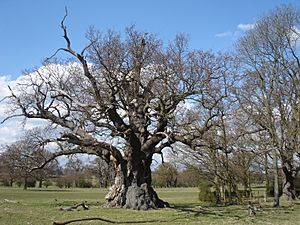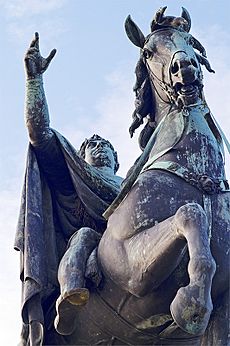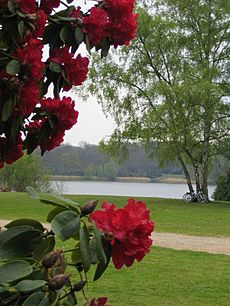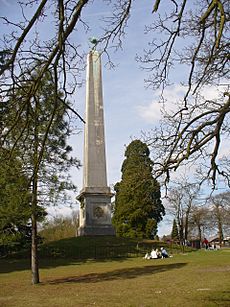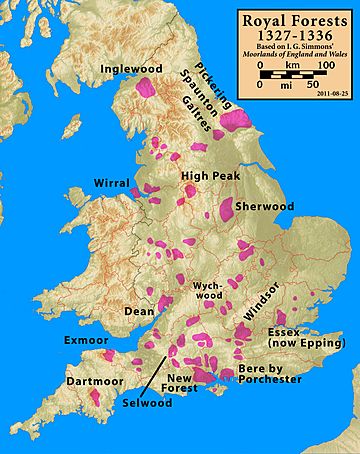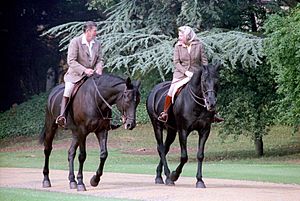Windsor Great Park facts for kids
Quick facts for kids Windsor Great Park |
|||||||||||||||
|---|---|---|---|---|---|---|---|---|---|---|---|---|---|---|---|
| Windsor Park | |||||||||||||||
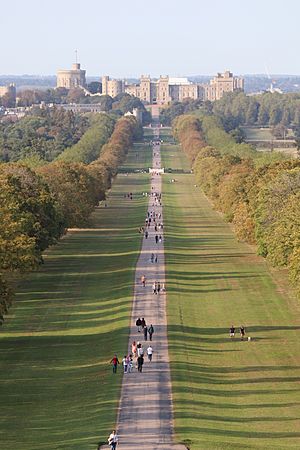
The Long Walk to Windsor Castle
|
|||||||||||||||
| Location | Windsor, Berkshire | ||||||||||||||
| Nearest city | London | ||||||||||||||
| Area | 2,020 hectares (5,000 acres) | ||||||||||||||
| Owned by | Crown Estate | ||||||||||||||
| Status | Open | ||||||||||||||
| Public transit access | |||||||||||||||
|
|||||||||||||||
Windsor Great Park is a huge royal park in England, covering about 2,020 hectares (5,000 acres) of land. It's located south of Windsor town, near the border of Berkshire and Surrey. This park includes a special area for deer. It's also right next to the smaller, private Home Park, which is closer to Windsor Castle.
For many centuries, Windsor Great Park was the private hunting ground for the kings and queens living at Windsor Castle. Its history goes back to the mid-13th century. In the past, the park was much bigger than it is today. It was known by names like Windsor Forest or Windsor Royal Park.
Unlike other royal parks, Windsor Great Park is managed and funded by the Crown Estate. This is a public body that looks after lands owned by the monarch. Most parts of the park are open to everyone, for free, from morning until evening. However, there is a small fee to enter the beautiful Savill Garden.
The park is considered very important historically and is listed on the Register of Historic Parks and Gardens. A large part of it, called Windsor Forest and Great Park, is also a special area for nature, known as a Site of Special Scientific Interest.
Contents
Exploring Windsor Great Park
Windsor Great Park has a varied and gently rolling landscape. You can find wide-open lawns where deer graze, small woods, and areas with huge, very old oak trees. A small river called the Battle Bourne flows through the north of the park towards the River Thames. Another river, the River Bourne, runs through several ponds in the south. The biggest of these are Great Meadow Pond and Obelisk Pond, which are close to the large Virginia Water Lake.
The highest point in the park is Snow Hill. From here, a long, straight path lined with trees, called the Long Walk, stretches all the way to Windsor Castle. You can enter the park through many gates, such as Queen Anne's Gate and Bishop's Gate. You can even still see parts of the original medieval park fence in some places. The main road into Windsor, Sheet Street (A332), goes through the northeast part of the park.
On the western side, there's a small community called The Village. It was built in the 1930s for workers on the Royal estate and has a shop and a school. Other important buildings in the park include the Royal Lodge, Cumberland Lodge, the Cranbourne Tower, and Norfolk Farm.
Amazing Features of the Park
The modern deer park is located at the northern end of Windsor Great Park. It's home to a large group of wild red deer. This shows how the park was originally used for hunting many centuries ago.
The Copper Horse Statue
The Long Walk is a famous path that goes south from Windsor Castle. It leads to the 1829 Copper Horse statue of King George III. This impressive bronze statue sits on top of Snow Hill, offering amazing views of the castle. The distance from Windsor Castle to The Copper Horse is about 2.65 miles (4.26 km). You can also find other horse statues in the park, including one of Prince Albert and one of Queen Elizabeth II.
The Royal Lodge
The Royal Lodge was first built as the Deputy Ranger's house in the middle of the park. In 1812, it became a private retreat for the Prince Regent. After he died, most of it was taken down. In the 1930s, the remaining parts were fixed up for the Duke and Duchess of York. They later became King George VI and Queen Elizabeth. Today, it is the official home of Prince Andrew, Duke of York and is not open to the public.
The Royal Chapel of All Saints
The Royal Chapel of All Saints was built in 1825 by Jeffry Wyattville. It was needed because the chapels at the Royal and Cumberland Lodges were too small for the growing number of royal staff. King George IV used it often while Windsor Castle was being renovated. Later, it was redesigned in a Gothic style. Queen Victoria often attended the chapel, as did King George VI and Queen Elizabeth before they became king and queen. Queen Elizabeth II still uses it regularly when she is at Windsor.
Cumberland Lodge
Cumberland Lodge is another important building in the park, built in 1652. After the monarchy was restored in 1660, it became the home of the Ranger of the Great Park. Each Ranger, like Sarah Churchill, added their own touch to the house.
Queen Victoria visited the Lodge often. Her daughter, Princess Helena of the United Kingdom, lived there for over 50 years. She oversaw major rebuilding after a fire in 1869 and more changes in 1912. In 1936, important discussions about King Edward VIII's desire to marry Wallis Simpson took place here. These talks led to him giving up the throne. In 1947, the King made the Lodge available to an educational charity. Today, this charity is known simply as Cumberland Lodge. It focuses on discussing important questions facing society. The grounds are usually not open to the public, but the house hosts conferences and lectures.
Cranbourne Tower
The private Cranbourne Tower can be easily seen from nearby paths. It is the only part left of Cranbourne Lodge, which was once the home of the Keeper of Cranbourne Chase. It is believed to be from the 16th century.
Savill Garden and Valley Gardens
In the southeast part of the park, near Englefield Green, you'll find the beautiful Savill Garden and Valley Gardens. These gardens were designed by Eric Savill in the 1930s and 1940s. They feature an amazing variety of flowers and trees from all over the world. Nearby are Smith's Lawn and the Polo Grounds, as well as the peaceful Heather Garden. The Savill Garden Visitor Centre has a gift shop, toilets, a restaurant, a coffee shop, and a plant shop. The gardens are open to visitors every day.
Virginia Water Lake
Virginia Water Lake, in the south of the park, is a large, man-made lake covering about 1 km2 (0.4 sq mi). It was created starting in the 1740s. Along the lake, you can see interesting features. One is a 30-metre-high (100 ft) tall Canadian totem pole, carved by Mungo Martin, Henry Hunt, and Tony Hunt Sr.. It was a gift to celebrate 100 years of British Columbia. Another feature is a collection of old Roman ruins. These were brought from Leptis Magna (now in Al-Khums, Libya) in 1816 and placed at Virginia Water in 1826.
The Obelisk Memorial
Next to a smaller lake, called Obelisk Pond, stands the Obelisk memorial. It honors Prince William Augustus, Duke of Cumberland. The inscription on it says:
This Obelisk raised by command of King George the Second commemorates the services of his son William Duke of Cumberland
The success of his arms and the gratitude of his father
This tablet was inscribed by His Majesty King William the Fourth.
Originally, it said "Culloden," but Queen Victoria had that changed to "Cumberland."
A Look at the Park's History
William the Conqueror started building Windsor Castle in the 11th century. It was a good spot for defense near the River Thames. A huge area called Windsor Forest south of the castle was set aside for the King's hunting. It also provided wood, deer, boar, and fish for the castle.
In 1129, the first "parker" (park keeper) was appointed. In 1240, King Henry III officially marked out the borders of the "Park." This area was much larger than the Great Park we know today. The castle was just a fortress back then. When hunting, King Henry would stay at the more comfortable manor house in Old Windsor. The title "Parker" still exists today as "Ranger of the Park." Prince Philip was the last person to hold this title.
Kings Edward I and Edward III used the park for jousting and tournaments. Edward III even had his royal stud there to provide horses for the Hundred Years' War. The moat at Bear's Rails once held the manor house of Wychamere. This was the home of William of Wykeham while he was building the castle. It was later used for bear-baiting.
Except for a short time when Oliver Cromwell made it private to help pay for the civil war, the park remained the personal property of the monarch. This changed during the time of King George III. Control over all Crown lands was then given to Parliament. Today, the Crown Estate owns and manages the park.
Changes in the 18th Century
By the 1700s, the park's importance for food had decreased. The new Hanoverian kings preferred to build and garden the land instead of just hunting. The Long Walk was first designed by King Charles II. The trees were planted by William of Orange in the 1680s. These elm trees lasted until World War II.
The Georges (kings named George) extended the Long Walk and added many features and monuments. These include the Copper Horse (showing George III) and the Obelisk (honoring William, Duke of Cumberland). George III even had 2,000-year-old Roman ruins brought from Libya and placed in the park.
Virginia Water Lake was started in 1746 by William, Duke of Cumberland. It's thought that prisoners of war from the recent Jacobite uprisings helped build it. The first lake was smaller and was destroyed in a flood in 1768. In 1780, Paul and Thomas Sandby began building a much larger lake. They also added an artificial waterfall, Meadow Pond, and Obelisk Pond. The lake replaced a small stream with the same name. This stream was likely named after Queen Elizabeth I, who was known as the "Virgin Queen."
The Park in the 19th and 20th Centuries
Queen Victoria probably loved the park the most. After her husband Albert died, she spent a lot of time there. She built a Royal Mausoleum for Albert at nearby Frogmore. She was later buried there herself, along with other members of the royal family.
In the 19th and early 20th centuries, a big event for farmers was the Christmas sale of animals from the Royal Windsor Estates. Buyers came from all over the country. For example, in 1850, fat heifers sold for £20 each.
In the 1920s, the Smith's Lawn area of the park began to be used for flying planes. This continued until the early 1950s. Improvements were made to the grass landing area in the mid-1930s. The Prince of Wales (later Edward VIII) used it to fly different types of aircraft.
During World War II, the park was used for various aviation activities. Vickers-Armstrongs built and maintained Wellington bombers here. It was also a landing ground for training planes. In 2016, the Duke of Edinburgh unveiled a memorial at Smith's Lawn. He had made his first solo flight from there in 1952.
During the World Wars, Smith's Lawn was also used to house soldiers. In the 1940s, much of the deer park was plowed and used for farming food. This meant hundreds of old trees were cut down. Over 200 large bombs fell on the land, including several V-2 rockets.
For the 1948 Summer Olympics, the park was used for the road cycling event. In the 1950s, the park was slowly turned into the public recreation area it is today. This included replanting Savill Gardens and creating the new Valley Gardens. In 1951, a large wall for climbing plants was built at Savill using bricks from bombed buildings in London. In 1958, a Totem pole was put up nearby. It was a gift from British Columbia to the Queen.
In the 1970s, some "Free Festivals" were held in the park. In 1973, the Windsor Great Park regulations were introduced to manage access. A new visitor center, designed by Glenn Howells Architects, opened in June 2006.
Visiting the Park
Access to the park through Rangers Gate is only for authorized vehicles. There are many other entrances for cars, horses, and people walking. You can get access to some private areas of the Great Park by applying for an annual key rental.
Rules for accessing the park are set out in the Windsor Great Park Regulations 1973. These rules are displayed on boards at most entrances.
Special Events at the Park
Every five or six years since 1993, Windsor Great Park has hosted WINGS. This is a large camp for Scouts and Girlguiding members. The last one was held in August 2014.
In 1957, a World Camp was held at four locations around the world to celebrate 100 years since the birth of Lord Baden-Powell, the founder of Guiding. Windsor Great Park was one of these special locations.
Filming Location
Windsor Great Park has been used as a filming location for many movies and TV shows. It was featured on the cover of Elton John's 1978 album A Single Man.
The Crown Estate allows the park to be used for filming. It has appeared in:
- Harry Potter and the Half Blood Prince
- Harry Potter and the Deathly Hallows (Parts 1 and 2)
- Pirates of the Caribbean
- Sir Ridley Scott's Robin Hood
- Snow White and the Huntsman
- Into the Woods (2014)
- The King's Speech (Cumberland Lodge was used)
- King Arthur: Legend of the Sword (2015)
- The Huntsman: Winter's War (2015)
- Bridget Jones's Baby (2015)
- Flowers (Channel 4, 2015)
- The Legend of Tarzan (2016)
- Cinderella (2015)
- Annihilation (2016)
- The Voyage of Doctor Dolittle (2018)
The park has been made to look like Scottish forests, the River Thames, and even the slopes of Mount Fuji! It has also been seen on TV shows like Countryfile and Midsomer Murders.
Places Nearby
- Ascot
- Egham and Royal Holloway, University of London
- Eton and Eton College
- Maidenhead
- Old Windsor and Datchet
- Slough
- Virginia Water, Englefield Green and Runnymede, near the River Thames. Here you can find the Air Forces Memorial and John F Kennedy memorial.
- Windsor and Windsor Castle
- Iver Heath, home to Pinewood Film Studios
Images for kids
See also
 In Spanish: Windsor Great Park para niños
In Spanish: Windsor Great Park para niños


